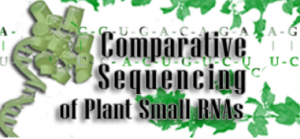Status:
Platform:
Species:
Small RNAs play an important role in plant development, stress responses, and epigenetic regulation, primarily through their role in transcriptional and post-transcriptional silencing of specific target genes and loci. Most if not all plants utilize these small RNA signaling networks. We have developed a deep-sequencing based dataset of plant small RNAs, based on the hypothesis that comparisons among the complex pool of small RNAs from diverse plants will identify novel types of conserved, regulated, or species-specific molecules. A database containing upward of hundreds of millions of plant small RNA sequences is being created for comparative analyses. This small RNA database will allow the experimental characterization of the majority of the biologically important small RNAs for a range of plant species. This database can be accessed from our website (http://smallrna.udel.edu/). A variety of web-based tools have been developed for analyses of these data. Here, we focus on these tools, and we describe how the users can implement these tools to analyze and interpret the small RNA data and how the users could use similar approaches for other sets of plant small RNAs from diverse species.[1]
Small RNAs are pivotal regulators of gene expression that guide transcriptional and post-transcriptional silencing mechanisms in eukaryotes, including plants. Here we report a comprehensive atlas of sRNA and miRNA from 3 species of algae and 31 representative species across vascular plants, including non-model plants. We sequence and quantify sRNAs from 99 different tissues or treatments across species, resulting in a data set of over 132 million distinct sequences. Using miRBase mature sequences as a reference, we identify the miRNA sequences present in these libraries. We apply diverse profiling methods to examine critical sRNA and miRNA features, such as size distribution, tissue-specific regulation and sequence conservation between species, as well as to predict putative new miRNA sequences. We also develop database resources, computational analysis tools and a dedicated website, http://smallrna.udel.edu/. This study provides new insights on plant sRNAs and miRNAs, and a foundation for future studies.[2]









